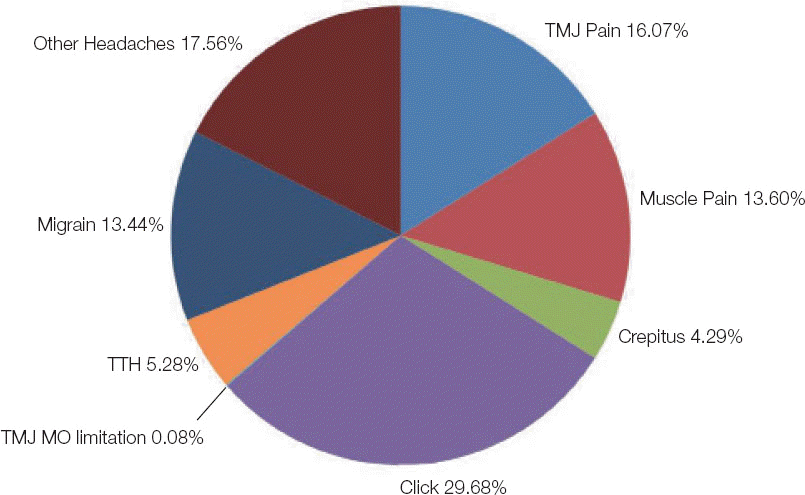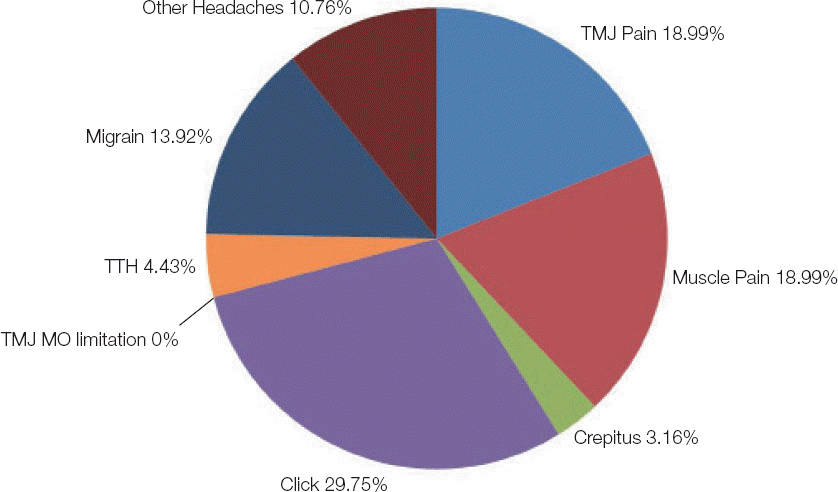1. Wadhwa S, Kapila S. TMJ disorders: future innovations in diagnostics and therapeutics. J Dent Educ. 2008; 72:930–47. PMID:
18676802. PMCID:
PMC2547984.
2. Drangsholt M, Le Resche L. Crombie IK, Croft PR, Linton SJ, Le Resche L, Von Korff M, editors. Temporomandibular disorder pain. Epidemiology of pain. 1999. Seattle, WA: IASP Press;p. 203–33.
3. McNeill C. Management of temporomandibular disorders: concepts and controversies. J Prosthet Dent. 1997; 77:510–22. DOI:
10.1016/S0022-3913(97)70145-8.
4. Salonen L, Helldén L, Carlsson GE. Prevalence of signs and symptoms of dysfunction in the masticatory system: an epidemiologic study in an adult Swedish population. J Craniomandib Disord. 1990; 4:241–50. PMID:
2098401.
6. Ballegaard V, Thede-Schmidt-Hansen P, Svensson P, Jensen R. Are headache and temporomandibular disorders related? A blinded study. Cephalalgia. 2008; 28:832–41. DOI:
10.1111/j.1468-2982.2008.01597.x. PMID:
18498400.
8. Glaros AG, Urban D, Locke J. Headache and temporomandibular disorders: evidence for diagnosticand behavioural overlap. Cephalalgia. 2007; 27:542–9. DOI:
10.1111/j.1468-2982.2007.01325.x. PMID:
17441972.
9. Suvinen TI, Reade PC, Hanes KR, Könönen M, Kemppainen P. Temporomandibular disorder subtypes according to self-reported physical and psychosocial variables in female patients: a reevaluation. J Oral Rehabil. 2005; 32:166–73. DOI:
10.1111/j.1365-2842.2004.01432.x. PMID:
15707426.
11. Rossetti LM, Pereira de Araujo Cdos R, Rossetti PH, Conti PC. Association between rhythmic masticatory muscle activity during sleep and masticatory myofascial pain: a polysomnographic study. J Orofac Pain. 2008; 22:190–200. PMID:
18780532.
12. Miyake R, Ohkubo R, Takehara J, Morita M. Oral parafunctions and association with symptoms of temporomandibular disorders in Japanese university students. J Oral Rehabil. 2004; 31:518–23. DOI:
10.1111/j.1365-2842.2004.01269.x. PMID:
15189307.
13. Winocur E, Gavish A, Finkelshtein T, Halachmi M, Gazit E. Oral habits among adolescent girls and their association with symptoms of temporomandibular disorders. J Oral Rehabil. 2001; 28:624–9. DOI:
10.1046/j.1365-2842.2001.00708.x. PMID:
11422693.
14. Nekora-Azak A, Evlioglu G, Ordulu M, Issever H. Prevalence of symptoms associated with temporomandibular disorders in a Turkish population. J Oral Rehabil. 2006; 33:81–4. DOI:
10.1111/j.1365-2842.2006.01543.x. PMID:
16457666.
15. Goulet JP, Lavigne GJ, Lund JP. Jaw pain prevalence among French-speaking Canadians in Québec and related symptoms of temporomandibular disorders. J Dent Res. 1995; 74:1738–44. DOI:
10.1177/00220345950740110401. PMID:
8530734.
16. Pow EH, Leung KC, McMillan AS. Prevalence of symptoms associated with temporomandibular disorders in Hong Kong Chinese. J Orofac Pain. 2001; 15:228–34. PMID:
11575193.
17. Gonçalves DA, Dal Fabbro AL, Campos JA, Bigal ME, Speciali JG. Symptoms of temporomandibular disorders in the population: an epidemiological study. J Orofac Pain. 2010; 24:270–8. PMID:
20664828.
18. Foxman I, Burgel BJ. Musician health and safety: Preventing playing-related musculoskeletal disorders. AAOHN J. 2006; 54:309–16. DOI:
10.1177/216507990605400703. PMID:
16862878.
19. Steinmetz A, Zeh A, Delank KS, Peroz I. Symptoms of craniomandibular dysfunction in professional orchestra musicians. Occup Med (Lond). 2014; 64:17–22. Epub 2013 Dec 11. DOI:
10.1093/occmed/kqt148.
20. Heikkilä J, Hamberg L, Meurman JH. Temporomandibular disorders: symptoms and facial pain in orchestra musicians in Finland. Music and Medicine. 2012; 4:171–6. DOI:
10.1177/1943862112445796.
21. Zuskin E, Schachter N, Kolcic I, Polasek O, Mustajbegovic J, Arumugam U. Health problems in musicians: a review. Acta Dermatovenerol Croat. 2005; 13:247–51. PMID:
16356400.
22. Attallah MM, Visscher CM, van Selms MK, Lobbezoo F. Is there an association between temporomandibular disorders and playing a musical instrument? A review of literature. J Oral Rehabil. 2014; 41:532–41. Epub 2014 Apr 5. DOI:
10.1111/joor.12166.
23. Glowacka A, Matthews-Kozanecka M, Kawala M, Kawala B. The impact of the long-term playing of musical instruments on the stomatognathic system - review. Adv Clin Exp Med. 2014; 23:143–6. DOI:
10.17219/acem/37038. PMID:
24596017.
25. Rodríguez-Lozano FJ, Sáez-Yuguero MR, Bermejo-Fenoll A. Prevalence of temporomandibular disorder-related findings in violinists compared with control subjects. Oral Surg Oral Med Oral Pathol Oral Radiol Endod. 2010; 109:e15–9. DOI:
10.1016/j.tripleo.2009.08.032. PMID:
20123363.
26. Gualtieri PA. May Johnny or Janie play the clarinet? The Eastman Study: a report on the orthodontic evaluations of college-level and professional musicians who play brass and woodwind instruments. Am J Orthod. 1979; 76:260–76. DOI:
10.1016/0002-9416(79)90023-X.
27. Howard JA, Lovrovich AT. Wind instruments: their interplay with orofacial structures. Med Probl Perform Art. 1989; 4:59–72.
29. Sayegh Ghoussoub M, Ghoussoub K, Chaaya A, Sleilaty G, Joubrel I, Rifaï K. Orofacial and hearing specific problems among 340 wind instrumentalists in Lebanon. J Med Liban. 2008; 56:159–67. PMID:
18792553.
30. Kovero O, Könönen M. Signs and symptoms of temporomandibular disorders and radiologically observed abnormalities in the condyles of the temporomandibular joints of professional violin and viola players. Acta Odontol Scand. 1995; 53:81–4. DOI:
10.3109/00016359509005951. PMID:
7610780.
31. Kovero O, Könönen M. Signs and symptoms of temporomandibular disorders in adolescent violin players. Acta Odontol Scand. 1996; 54:271–4. DOI:
10.3109/00016359609003536. PMID:
8876740.
32. Steinmetz A, Ridder PH, Methfessel G, Muche B. Professional musicians with craniomandibular dysfunctions treated with oral splints. Cranio. 2009; 27:221–30. PMID:
19891256.
34. Okner M, Kernozek T, Wade M. Chin rest pressure in violin playing: musical repertoire, chin rests and shoulder pads as possible mediators. Med Probl Perf Art. 1997; 12:112–21.
35. Steinmetz A, Ridder PH, Reichelt A. Craniomandibular dysfunction and violin playing: prevalence and the influence on head and neck muscles in violinists. Med Probl Perform Art. 2006; 2l:183–9.
36. Kovero O. Degenerative temporomandibular joint disease in a young violinist. Dentomaxillofac Radiol. 1989; 18:133–5. DOI:
10.1259/dmfr.18.3.2637880. PMID:
2637880.
38. Taddey JJ. Musicians and temporomandibular disorders: prevalence and occupational etiologic considerations. Cranio. 1992; 10:241–4. PMID:
1423687.
39. Franco AL, Gonçalves DA, Castanharo SM, Speciali JG, Bigal ME, Camparis CM. Migraine is the most prevalent primary headache in individuals with temporomandibular disorders. J Orofac Pain. 2010; 24:287–92. PMID:
20664830.
40. LeResche L. Epidermiology of temporomandibular disorders: implications for the investigation of etiologic factors. Crit Rev Oral Biol Med. 1997; 8:291–305. DOI:
10.1177/10454411970080030401. PMID:
9260045.




 PDF
PDF Citation
Citation Print
Print






 XML Download
XML Download